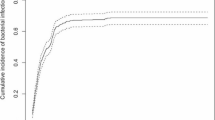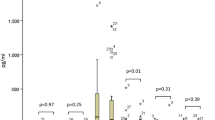Abstract
Pediatric oncology patients are usually immunosuppressed due to factors such as the neoplasm and its treatment, making them more susceptible to infections. This article aims to determine the infection profile of pediatric oncology patients admitted to an oncology reference hospital in Natal, Rio Grande do Norte, Brazil. A retrospective and cross-sectional study was conducted, collecting data from patients hospitalized due to infection in a pediatric oncology unit exclusively for the Brazilian public health system, spanning from 2018 to 2021. A total of 168 episodes of infections were identified in 96 patients, resulting in 157 hospitalizations. Among the patients with infections, 62.4% had hematological malignancies, and out of these cases, 74.6% specifically had Acute Lymphoid Leukemia. The Escherichia coli (31.9%) was the most prevalent microorganism isolated from the samples. Multidrug-resistant microorganisms accounted for 52% of all identified microorganisms. Fluoroquinolones and beta-lactam were the most prevalent antibiotic classes in the analyzed antibiograms. Factors such as Sex, type of cancer, chemotherapy in the last 30 days, were found to be associated with the occurrence of infection (p < 0.05). Conducting epidemiological studies regarding infections in pediatric oncology is crucial to development of empirical protocols, and the implementation of strategies to better control future infections.


Similar content being viewed by others
References
Costa P, Atta E, Silva R (2015) Infection with multidrug-resistant gram-negative bacteria in a pediatric oncology intensive care unit: risk factors and outcomes. Curr Microbiol 91(5):435–441. https://doi.org/10.1007/s00284-015-0847-5
Guilcher GMT et al (2021) Immune function in childhood cancer survivors: a children’s Oncology Group review. Curr Microbiol 5(4):284–294. https://doi.org/10.1016/j.lanchad.2020.10.013
Sung L et al (2012) Life-threatening and fatal infections in children with acute myeloid leukemia: a report from the children’s Oncology Group. Curr Microbiol 34(1):1–11. https://doi.org/10.1097/MPH.0B013E31822817A6
Facciolà A et al (2019) The role of the hospital environment in healthcare-associated infections: a general review of the literature. Curr Microbiol 23(3):1266–1278. https://doi.org/10.1007/s10096-019-03447-6
Partridge SR et al (2018) Mobile genetic elements associated with antimicrobial resistance. Curr Microbiol 31(4):291–303. https://doi.org/10.1128/CMR.00088-17
Wolf J et al (2017) Levofloxacin prophylaxis during induction therapy for pediatric acute lymphoblastic leukemia. Curr Microbiol 65(11):1790–1798. https://doi.org/10.1093/cid/cix64
Boeriu E et al (2022) Diagnosis and management of febrile neutropenia in pediatric oncology patients—a systematic review. Curr Microbiol 12(8):1800–1820. https://doi.org/10.3390/diagnostics12081800
Groll AH et al (2021) 8th european conference on infections in leukemia: 2020 guidelines for the diagnosis, prevention, and treatment of invasive fungal diseases in pediatric patients with cancer or post-hematopoietic cell transplantation. Curr Microbiol 22(6):e254–e269. https://doi.org/10.1016/j.eclinm.2020.100433
Flasche S, Atkins KE (2018) Balancing benefits and risks of antibiotic use. Curr Microbiol 218(9):1351–1353. https://doi.org/10.1093/infdis/jiy344
Lambert ML et al (2011) Clinical outcomes of healthcare-associated infections and antimicrobial resistance in patients admitted to european intensive-care units: a cohort study. Curr Microbiol 11(30):30–38. https://doi.org/10.1016/S1473-3099(10)70258-9
Montassier E et al (2013) Recent changes in bacteremia in patients with cancer: a systematic review of epidemiology and antibiotic resistance. Curr Microbiol 32(7):841–850. https://doi.org/10.1007/s10096-013-1819-7
Donà D et al (2020) Implementation and impact of pediatric antimicrobial stewardship programs: a systematic scoping review. Curr Microbiol 9(1):1–12. https://doi.org/10.1186/S13756-019-0659-3
Hulscher ME, Grol RP, van der Meer JW (2010) Antibiotic prescribing in hospitals: a social and behavioural scientific approach. Lancet Infect Dis 10:167–175. https://doi.org/10.1016/S1473-3099(10)70027-X
Levy E, Swami S, Dubois S, Wendt R, Banerjee R (2012) Rates and appropriateness of Antimicrobial prescribing at an academic children’s hospital, 2007–2010. Infect Control Hosp Epidemiol 33:4. https://doi.org/10.1086/664761
Siebel R, Marchioro M, Bueno D (2012) “Estudo de prescrições de antineoplásicos e antimicrobianos em uma unidade de oncologia pediátrica.“ Rev HCPA 32:3 : 303–310. Available: http://seer.ufrgs.br/hcp
Trecarichi EM, Tumbarello M (2014) Antimicrobial-resistant Gram-negative bacteria in febrile neutropenic patients with cancer: current epidemiology and clinical impact. Curr Opin Infect Dis 27:2. https://doi.org/10.1097/QCO.0000000000000038
Wolf J et al (2016) Antimicrobial stewardship barriers and goals in Pediatric Oncology and Bone Marrow transplantation: a Survey of Antimicrobial Stewardship Practitioners. Infect Control Hosp Epidemiol 37(3):343–347. https://doi.org/10.1017/ICE.2015.295
Knight T, Gupte A, Dulay K, Mitchell R, Salimnia H, Wang ZJ (2020) Evaluation of an empiric antibiotic regimen in pediatric oncology patients presenting with fever does not reveal the emergence of antibiotic resistance over a 12-year period. Pediatr Hematol Oncol J 5:3. https://doi.org/10.1016/J.PHOJ.2020.06.011
Hassan R et al (2020) Genotypic characterization of multiple drug resistant Escherichia coli isolates from a pediatric cancer hospital in Egypt. " Sci Rep 10:1. https://doi.org/10.1038/s41598-020-61159-z
Dandoy CE et al (2019) Outcomes after bloodstream infection in hospitalized pediatric hematology/oncology and stem cell transplant patients. Pediatr Blood Cancer 66:12. https://doi.org/10.1002/pbc.27978
Elseady NSM et al (2021) Antibiotic sensitivity/resistance pattern of hospital-acquired bloodstream infection in children cancer patients: a retrospective study. Int J Clin Pract 75(10):e14617. https://doi.org/10.1111/ijcp.14617
Tural Kara T et al (2019) Bloodstream infections in pediatric hematology/oncology patients: six years’ experience of a single center in Turkey. Turk J Med Sci 49(4):1157–1164. https://doi.org/10.3906/sag-1812-101
Mattei D et al (2022) Characteristics and outcomes of Bloodstream Infections in a Tertiary-Care Pediatric hematology–oncology unit: a 10-Year study. J Clin Med 11(3):880. https://doi.org/10.3390/jcm11030880
Sociedade Brasileira de Pediatria. Manual de Orientação: Consulta do adolescente: abordagem clínica, orientações éticas e legais como instrumentos ao pediatra (2019) Accessed Oct. 18, 2022. Available: https://www.sbp.com.br/fileadmin/user_upload/21512c-MO_-_ConsultaAdolescente_-_abordClinica_orientEticas.pdf
Clinical and Laboratory Standards Institute. Performance Standards for Antimicrobial Susceptibility Testing. Feb. 2022. Accessed Jan. 27, 2023. Available: https://clsi.org/standards/products/microbiology/documents/m100/
Stewart BW, Wild CP (2014) World Cancer Report 2014.
Gavhane YN et al (2011) Solid tumors: facts, Challenges and Solutions. Int J Pharma Sci Res 2(1):1–12
Magiorakos AP et al (2012) Multidrug-resistant, extensively drug-resistant and pandrug-resistant bacteria: an international expert proposal for interim standard definitions for acquired resistance. Clin Microbiol Infect 18(3):268–281. https://doi.org/10.1111/j.1469-0691.2011.03570.x
Boeriu E et al (2022) Diagnosis and management of Febrile Neutropenia in Pediatric Oncology Patients—A. Syst Rev Diagnostics 2022 12(8):1800. https://doi.org/10.3390/diagnostics12081800
Chung SC, Mueller S, Green K, Chang WH, Hargrave D, Lai AG (2022) Multimorbidity patterns and risk of hospitalization in children: a population cohort study of 3.6 million children in England, with illustrative examples from childhood cancer survivors. Lancet Reg Health Eur 20:100433. https://doi.org/10.1016/j.lanepe.2022.100433
Kruizinga MD et al (2021) The impact of lockdown on pediatric ED visits and hospital admissions during the COVID-19 pandemic: a multicenter analysis and review of the literature. Eur J Pediatr 180(7):2271–2279. https://doi.org/10.1007/s00431-021-04015-0
Nguyen JL et al (2022) Pandemic-related declines in hospitalization for non-COVID-19-related illness in the United States from January through July 2020. PLoS ONE 17(1):e0262347. https://doi.org/10.1371/journal.pone.0262347
Global Health Research Group on Children’s Non-Communicable Diseases Collaborative (2022) Impact of the COVID-19 pandemic on patients with pediatric cancer in low-income, middle-income, and high-income countries: a multicenter, international, observational cohort study. BMJ Open 12(4):e054690. https://doi.org/10.1136/bmjopen-2021-054690
World Health Organization. Cancer Tomorrow (2020) Accessed Jan. 16, 2023. Available: https://gco.iarc.fr/tomorrow/en/dataviz/isotype?years=2025&single_unit=10000&age_end=3
Siegel RL, Miller KD, Fuchs HE, Jemal A, Cancer Statistics (2021) CA Cancer J Clin. 2021;71(1):7–33. doi: https://doi.org/10.3322/CAAC.21654
Garrido MM, Garrido RQ, Cunha TN, Ehrlich S, Martins IS (2019) Comparison of epidemiological, clinical and microbiological characteristics of bloodstream infection in children with solid tumors and hematological malignancies. Epidemiol Infect 147:e298. https://doi.org/10.1017/S0950268819001845
Sociedade Brasileira de Pediatria. Diretrizes para o manejo inicial da neutropenia febril, após quimioterapia, em crianças e adolescentes com câncer (2018) ;2
Delebarre M et al (2019) Differential risk of severe infection in febrile neutropenia among children with blood cancer or solid tumor. J Infect 79(2):95–100. https://doi.org/10.1016/J.JINF.2019.06.008
Kato M, Manabe A (2018) Treatment and biology of pediatric acute lymphoblastic leukemia. Pediatr Int 60(1):4–12. https://doi.org/10.1111/PED.13457
UpToDate (2023) Accessed Jan. 28, 2023. Available: https://www.uptodate.com/contents/search
Instituto Nacional de Câncer. Versão para profissionais de saúde — Português (Brasil) (2020) Accessed Jan. 01, 2023. Available: https://www.gov.br/inca/pt-br/assuntos/cancer/tipos/infantojuvenil/especificos/osteossarcoma/versao-para-profissionais-de-saude
Benjamin RS (2020) Adjuvant and neoadjuvant chemotherapy for osteosarcoma: a historical perspective. Adv Exp Med Biol 1257:1–10. https://doi.org/10.1007/978-3-030-43032-0_1
Li M, Du M, Li H, Liu D, Liu Y (2022) Epidemiology, resistant pathogens, and causes of early death in cases of bloodstream infection in patients with hematological malignancies from 2012–2019. Infect Med 1(1):23–30. https://doi.org/10.1016/J.IMJ.2022.02.002
lo Menzo S, la Martire G, Ceccarelli G, Venditti M (2015) New Insight on Epidemiology and Management of bacterial bloodstream infection in patients with hematological malignancies. Mediterr J Hematol Infect Dis 7(1). https://doi.org/10.4084/MJHID.2015.044
Perez F, Adachi J, Bonomo RA (2014) Antibiotic-resistant gram-negative bacterial infections in patients with cancer. Clin Infect Dis 59(Suppl 5):S335–S339. https://doi.org/10.1093/CID/CIU612
Esposito S et al (2022) Antibiotic resistance in paediatric febrile urinary tract infections. J Glob Antimicrob Resist 29:499–506. https://doi.org/10.1016/j.jgar.2021.11.003
Kamel NA et al Phenotypic screening and molecular characterization of carbapenemase-producing gram-negative Bacilli recovered from Febrile Neutropenic Pediatric Cancer Patients in Egypt. PLoS ONE 13.8 (2018): e0202119. doi: https://doi.org/10.1371/journal.pone.0202119
Ashour HM, El-Sharif A (2009) Species distribution and Antimicrobial susceptibility of Gram-Negative aerobic Bacteria in Hospitalized Cancer Patients. J Transl Med 7(1):14. https://doi.org/10.1186/1479-5876-7-14
Woodford N et al (2011) Multiresistant gram-negative Bacteria: the role of high-risk clones in the dissemination of Antibiotic Resistance. FEMS Microbiol Rev 35(5):736–755. https://doi.org/10.1111/j.1574-6976.2011.00268.x
Moxon CA, Paulus S (2016) Beta-Lactamases in Enterobacteriaceae Infections in Children. J Infect 72:S41–S49. https://doi.org/10.1016/j.jinf.2016.04.021
Talan DA et al (2021) Emergence of extended-spectrum β-Lactamase urinary tract infections among hospitalized Emergency Department Patients in the United States. Ann Emerg Med 77(1):32–43. https://doi.org/10.1016/j.annemergmed.2020.08.022
Autore G et al (2022) Management of Pediatric urinary tract infections: a Delphi Study. Antibiotics 11:1122. https://doi.org/10.3390/ANTIBIOTICS11081122/S1
Stein R et al (2015) Urinary Tract Infections in Children: EAU/ESPU Guidelines. Eur. Urol. 67.3 : 546–558. doi: 10.1016/J.EURURO.2014.11.007
American Academy of Pediatrics Committee on Infectious Diseases. Red Book (2018) : Report of the Committee on Infectious Diseases. Red Book (2018). May 2018. doi: https://doi.org/10.1542/9781610021470
Lehrnbecher T et al (2017) Guideline for the management of Fever and Neutropenia in Children with Cancer and hematopoietic stem-cell transplantation recipients: 2017 update. J Clin Oncol 3518:2082–2094. https://doi.org/10.1200/JCO.2016.71.7017
Zerati AE et al (2017) Cateteres venosos totalmente implantáveis: histórico, técnica de implante e complicações. J Vasc Bras 16(2):128–139. https://doi.org/10.1590/1677-5449.008216
Zhou Y et al (2022) Totally implantable venous Access Ports: a systematic review and Meta-analysis comparing subclavian and internal jugular vein punctures. Phlebology 37(4):279–288. https://doi.org/10.1177/02683555211069772
Rabelo BS et al (2022) Risk factors for catheter-related infection in children with Cancer: a systematic review and Meta-analysis. Am J Infect Control. https://doi.org/10.1016/J.AJIC.2022.05.005
Acknowledgements
The authors thank the Liga Norte Riograndense Hospital for conducting this study. The authors also thank all the team of unit pediatric and Instituto de Ensino Pesquisa e Inovação this hospital who helped the researchers during the data collection.
Funding
This research received no specific grant from any funding agency, commercial or not-for-profit sectors.
Author information
Authors and Affiliations
Contributions
JFVF: responsible for conceptualization, methodology, formal analysis, investigation, writing - manuscript drafting. VNR: contributed to data collection - manuscript drafting. AMAdoN: conducted the methodology, formal analysis, and writing - review and editing. MMAdeM: responsible for conceptualization, methodology, writing - review and editing, supervision and project administration. All authors contributed equally toward the elaboration of the manuscript and have given their approval of the final version.
Corresponding author
Ethics declarations
Ethical Approval
The project was submitted to the Ethics and Research Committee and approved with CAAE 52958021.6.0000.5293. As secondary data were obtained, this work did not require the application of a free and informed consent.
Conflicts of interest
On behalf of all authors, the corresponding author states that there is no confict of interest.
Additional information
Publisher’s Note
Springer Nature remains neutral with regard to jurisdictional claims in published maps and institutional affiliations.
Electronic Supplementary Material
Below is the link to the electronic supplementary material.
Rights and permissions
Springer Nature or its licensor (e.g. a society or other partner) holds exclusive rights to this article under a publishing agreement with the author(s) or other rightsholder(s); author self-archiving of the accepted manuscript version of this article is solely governed by the terms of such publishing agreement and applicable law.
About this article
Cite this article
Vieira Filho, J.F., Ribeiro, V.N., do Nascimento, Á.M.A. et al. Infections in Children with Cancer Admitted in an Oncology Reference Hospital: A Cross-sectional Study. Curr Microbiol 80, 315 (2023). https://doi.org/10.1007/s00284-023-03420-y
Received:
Accepted:
Published:
DOI: https://doi.org/10.1007/s00284-023-03420-y




